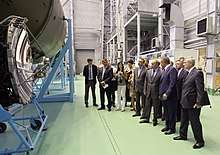Energia (corporation)
PAO S. P. Korolev Rocket and Space Corporation Energia (Russian: Ракетно-космическая корпорация «Энергия» им. С. П. Королёва, romanized: Raketno-kosmicheskaya korporatsiya “Energiya” im. S. P. Korolyova), also known as RSC Energia (РКК «Энергия», RKK “Energiya”), is a Russian manufacturer of ballistic missile, spacecraft and space station components. The company is the prime developer and contractor of the Russian crewed spaceflight program; it also owns a majority of Sea Launch.[5] Its name is derived from Sergei Korolev, the first chief of its design bureau, and the Russian word for energy.
 | |
Formerly | OKB-1 |
|---|---|
| Public | |
| Traded as | |
| Industry | Space industry Aerospace industry Defense industry |
| Founded | 26 August 1946[1] |
| Founders | Sergei Korolev |
| Headquarters | , RUS |
| Products | Ballistic missiles, Launch vehicles, Satellites, Spacecraft, Space stations |
| Revenue | $726 million[2] (2017) |
| $37.8 million[2] (2017) | |
| $21.1 million[2] (2017) | |
| Total assets | $1.97 billion[2] (2017) |
| Total equity | $65.3 million[2] (2017) |
| Owner | United Rocket and Space Corporation (38.2%)[3] |
Number of employees | 7,791[4] (2017) |
| Divisions | NPO Energomash |
| Website | www.energia.ru/english/ |
Overview
Energia is the largest company of the Russian space industry and one of its key players. It is responsible for all operations involving human spaceflight and is the lead developer of the Soyuz and Progress spacecraft, and the lead developer of the Russian end of the International Space Station. In the mid-2000s, the company employed 22,000–30,000 people.[6]
The enterprise has been awarded with 4 Orders of Lenin, Order of the October Revolution and Russian Federation President's Message of Thanks. In addition, 14 cosmonauts employed by the company have been awarded the title "Hero of the Russian Federation".[7]
Structure

The company consists of the following subsidiaries and branches:[7]
- Primary Design Bureau
- Baikonur branch
- ZAO Experimental Machine-building Plant
- ZAO Volzhskoye DB
- ZAO PO Kosmos
As of 2009, 38% of the company's stock was owned by the Russian state.[7]
History
The company was founded on 26 August 1946[1]D and has been known successively as:
- Special Design Bureau number 1 of R&D Institute number 88 (Russian: ОКБ-1 НИИ-88 or OKB-1 of NII-88)
- TsKBEM (Central Design Bureau of Experimental Machine Building) [8]
- NPO Energia
- S. P. Korolev RSC Energia.
It is named after the first chief of its design bureau Sergei Korolev (1946–1966). His successors as chief designers were: Vasiliy Mishin (1966–1974), Valentin Glushko (1974–1989), Yuriy Semenov (1989–2005), Nikolay Sevastyanov (2005–2007). Its President and Chief designer was Vitaly Lopota, until 1 August 2014.[9]
Korolev's design bureau was, beginning with the first artificial satellite Sputnik 1 and the first crewed spaceflight of Vostok 1, responsible for a major part of the Soviet space program. It was the main rival of OKB-52 (later known as TsKBM, then the design bureau of Vladimir Chelomei) during the Soviet crewed lunar programs and the Soviet space station program.[10] OKB-1 was among others responsible for the development of the crewed Soyuz spacecraft and its Soyuz rocket, the N1 "Moon Shot" rocket, large parts of the Salyut space station program, the uncrewed Progress resupply craft and designed the Energia rocket for the Buran space shuttle program. Since the early beginnings of the Luna programme it designed many space probes, among others of the Venera, Zond and Mars program.
The company continues to dominate a large part of the Russian space program, and a considerable part of the World's space program, with its Soyuz spacecraft having become the only crewed spacecraft conducting regular flights and the exclusive crew transport vehicle for the International Space Station from the Space Shuttle retirement in 2011 and until the maiden flight of Crew Dragon Endeavour in 2020. The Chinese Shenzhou program is the only other program in the world with planned semi-regular crewed spaceflights.
The President of Energia, Vitaly Lopota, was removed from his post as president on August 1, 2014. Dmitry Rogozin indicated that this was the start of "Long-awaited personnel reform in [the Russian] space industry ... Tough times require tough decisions."[9] Lopota was offered the position of vice president for technological development in the United Rocket and Space Corporation,[9] the new company formed in 2013 to re-nationalize the Russian space industry.[11]
Ongoing projects
- Energia builds Russia's Soyuz MS spacecraft for 3-person human spaceflight missions and Progress M robotic spacecraft for cargo missions.
- Russian segment of ISS: providing its own cosmonauts for ISS expeditions; responsibility for all Russian scientific experiments.
- Sea Launch project participation – production of block DM-SL as the upper stage for Ukrainian launch vehicle Zenit-3SL.
- Universal Spacecraft Configuration – usage for development of: communications satellites, remote sensing satellites, navigation satellites and uncrewed orbital servicing satellites. USC was a basis for Yamal 100 and Yamal 200 satellites.
Future projects
- Further assembly of ISS Russian segment: development of Multipurpose Laboratory Module (together with Krunichev Space Centre) and "Oka" space production modules (not permanently attached to ISS).
- Development of new spacecraft with 3 stages:
- Modernization of "Soyuz TMA" spacecraft for human circum-lunar missions – pending commercial orders for space tourism.
- Development of "Parom" space tug (in order to replace Progress M cargo spacecraft).
- Development of multi-aimed Orel spacecraft (instead of abandoned Kliper project) for 6 persons.
- Development of crewed lunar program: landing by 2025, creating of permanent lunar base by 2030 in order to extract helium-3.
- Development of human Mars mission: landing beyond 2035.
- Development of Yamal-300 and Yamal-400 communication satellites for Gazprom corporation.
- Development of "Smotr" remote sensing satellites.
- Development of a pod designed for clearing near-Earth space of satellite debris. The new device is planned to be assembled by 2020 and tested by 2023. The concept is to build the device to use a nuclear power source so that it could remain on task for up to 15 years, primarily working in the geosynchronous orbit zone. Debris collected would be de-orbited to re-enter over the ocean.[12]
Historic projects
Over the years the products of Energia and its predecessors included:
IRBMs and ICBMs
Including meteorological rockets as their modifications.
- R-1 (missile) R-1B, R-1V, R-1D, R-1E
- R-2 (missile)
- R-5 missile, R-5M, R-11, R-11A, R-11F
- R-7 Semyorka,
- R-9 Desna
- RT-1
- RT-2
Launch vehicles
- R-7 (rocket family)
- Sputnik (rocket)
- Luna (rocket)
- Vostok (rocket family)
- Polyot (rocket)
- Voskhod (rocket)
- Molniya (rocket)
- Soyuz (rocket family)
- Soyuz/Vostok
- N1 rocket as a part of N1-L3 lunar complex
- Blok D
- Energia
- Energia II
- "Yamal", "Kvant", "Kvant-1", "Avrora";
- upper stages for different kinds of launch vehicles: blocks L and DM;
Research, Observation and Communication Earth Satellites
- Sputnik program
- Elektron (satellite)
- Zenit (satellite)
- Molniya (satellite)
- Signal (satellite)
- BelKA
- DZZ
Deep Space Exploration Spacecraft
- Luna programme
- Luna 1958A
- Luna 1958B
- Luna 1958C
- Luna 1
- Luna 1959A
- Luna 2
- Luna 3
- Luna 1960A
- Luna 1960B
- Luna 1963B
- Luna 4
- Luna 1964A
- Luna 1964B
- Cosmos 60
- Luna 1965A
- Luna 5
- Luna 6
- Luna 7
- Luna 8
- Luna 9
- Cosmos 111
- Luna 10
- Luna 1966A
- Luna 11
- Luna 12
- Luna 13
- Luna 1968A
- Luna 14
- Luna 1969A
- Luna 1969B
- Luna 1969C
- Luna 15
- Cosmos 300
- Cosmos 305
- Luna 1970A
- Luna 1970B
- Luna 16
- Luna 17
- Luna 18
- Luna 19
- Luna 20
- Luna 21
- Luna 22
- Luna 23
- Luna 1975A
- Luna 24
- Luna 8K72
- Venera
- Mars program
- Zond program
Crewed spacecraft
- Vostok programme
- Voskhod programme
- Soyuz programme
- Soyuz (spacecraft)
- Soyuz A
- Soyuz B
- Soyuz 7K-L1
- Soyuz 7K-L3
- Soyuz 7K-LOK
- Soyuz 7K-OK
- Soyuz 7K-OKS
- Soyuz 7K-T
- Soyuz 7K-TM
- Soyuz-T
- Soyuz-TM
- Soyuz TM-1
- Soyuz-TMA
- Soyuz TMA-M
- Soyuz-V
- Military Soyuz
- Soyuz (spacecraft)
- Buran programme
- Kliper
- LK (spacecraft)
- Orel (spacecraft)
Lunar Orbital Spacecraft
- Soyuz A
- Soyuz 7K-L1
- Soyuz 7K-L3 with Lunar Landing Module (as a part of N1-L3 lunar complex).
Committee of Innovative Youth Projects

Committee of Innovative Youth Projects (Russian: Комитет инновационных проектов молодежи) also known as KIPM of RSC Energia is a network structure that unites specialists and heads of different divisions to quickly develop and launch innovative products. KIPM was established in early 2016 on the initiative of a group of young engineers from the RSC Energia. The main task of the new structure is to give young specialists the opportunity to realize their creative ideas. The main criterion for projects selecting is their potential demand in the market. Currently KIPM work on five projects:
- Unmanned aerial vehicle remote power supply
- 1U-6U Cubesat Deployer
- Parachute system with an elastic linkage and tandem cargo separation
- Assembly of lunar expedition complex at LEO
- Hardware and software system for space experiments onboard crewed space station
See also
- RKK Energiya museum
- Aerospace manufacturer
- Soyuz spacecraft
- MirCorp
- NewSpace
- Kliper
- Orbital Technologies Commercial Space Station
- Parom
- Prospective Piloted Transport System
- United Rocket and Space Corporation
- Roscosmos
References
- "S.P. Korolev Rocket and Space Corporation Energia". Retrieved 29 May 2020.
- http://e-disclosure.ru/portal/files.aspx?id=1615&type=3.
- "Список аффилированных лиц". e-disclosure.ru. Retrieved 26 August 2017.
- https://www.energia.ru/ru/disclose/adocs/buh_otchet_2017.pdf.
- "Business briefs". Archived from the original on November 12, 2010. Retrieved 2010-11-10.
- Harvey, Brian (2007). "The design bureaus". The Rebirth of the Russian Space Program (1st ed.). Germany: Springer. ISBN 978-0-387-71354-0.
- "OAO Rocket and Space Corporation Energia after S.P. Korolev". OAO Energia. Retrieved 2009-10-05.
- "Tragic Tangle". System Failure Case Studies. NASA. 4 (10). 2010. Archived from the original on 8 April 2013. Retrieved 30 August 2012.
- "Chief of RSC Energia removed from his post". Space Digest. 2014-08-02. Archived from the original on August 8, 2014. Retrieved 2014-08-03.
- "Almaz". RussianSpaceWeb.com.
- Messier, Doug (2013-10-09). "Rogozin Outlines Plans for Consolidating Russia's Space Industry". Parabolic Arc. Retrieved 2014-08-03.
- "Russia To Spend 2 Bln Dollars For Space Clean-Up". Retrieved 2010-11-24.